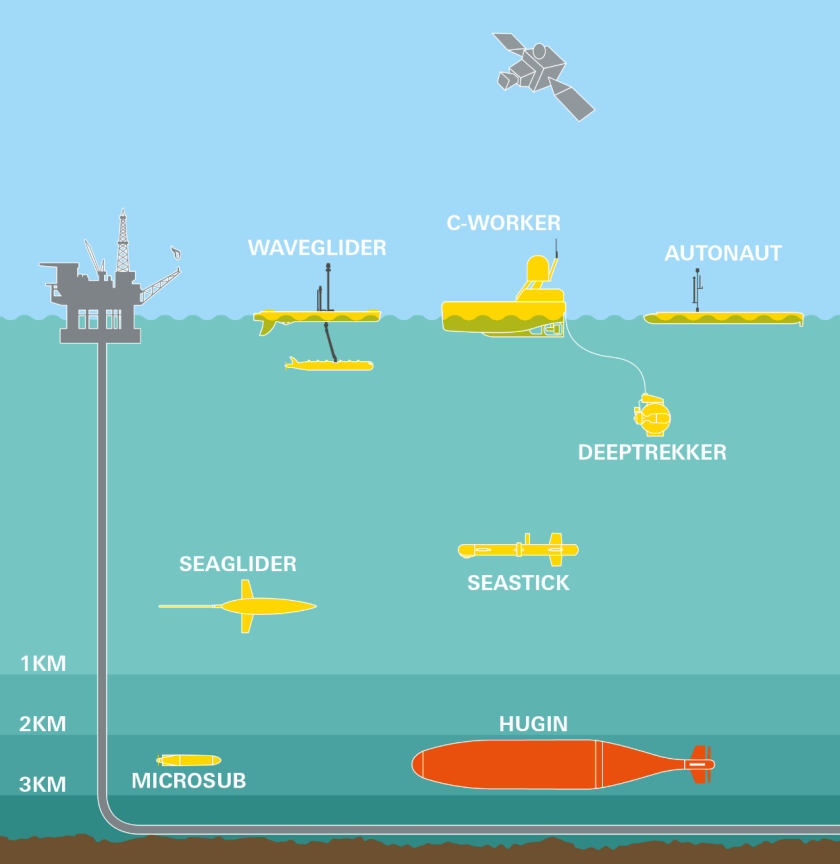
A new generation of underwater robots are helping BP learn more about the subsea environment.
The company is behind a push to develop new marine autonomous systems (MAS). The new generation of subsea vehicles are loaded with sensors and cameras that are helping capture data from the world’s oceans faster, safer and cheaper than before.
MAS, which include both autonomous surface vehicles (ASVs) and autonomous underwater vehicles (AUVs), help BP freely explore its remote offshore operating environments. These vehicles can transmit an immense amount of data in near real-time, so scientists can accurately monitor the oceanic environment, assess risks, or effectively manage a crisis.
Large-scale remotely operated vehicles (ROVs) and divers need to be deployed and supported by very large crews and vessels, often at huge cost.
Battery-powered and pre-programmed, MAS can quickly launch from sea, shore or sky and remain independently active in the ocean for up to months at a time. While autonomous by design, technicians can communicate with the vehicles by satellite to give navigation commands or receive data. At the end of the mission, a surface vessel picks them up.
The technology dates back to the 50s but advances in computer processing have improved capability and reduced costs to the point where the vehicles can take over underwater surveillance duties.
BP has partnered with manufacturer Oceaneering for a large-scale AUV trial to survey pipelines and subsea infrastructure in the Gulf of Mexico, ahead of a full roll-out.
BP’s global environmental response expert, Peter Collinson, says: “MAS open up a new scale of environmental assessment: whether that’s natural change, or the effects of industry operations. With more data, we have a clearer insight of what’s going on.
Unlike ROVs, which need to be tethered to and controlled by a ship, an AUV can quickly launch and get straight to work. This is a massive advantage in an emergency, when greater awareness and faster response times can help minimise environmental damage.
Little adds: “The advancement of robotics has moved us to an entirely new class of vehicles that are significantly smaller and more agile. They’re also considerably lower in cost [than ROVs], which means we can use more of them to multiply the data we can get, and therefore make more informed decisions.”
Combined with a better understanding of the environment, the low cost of the vehicles could lead to more frequent and detailed inspections of subsea infrastructure, giving earlier warning of any potential issues.
As well as this, in some situations, MAS avoids the need to send divers into the water, and allows exploration of areas that were previously inaccessible or inhospitable.
In 2010, Wave Glider surface vehicles were used during the Deepwater Horizon oil spill response to monitor for oil on the sea surface. Five years later, BP teamed up with the Scottish Association of Marine Science (SAMS) to test underwater vehicles’ rapid-strike capability in the North Sea.
Responding to a simulated incident in an oilfield west of Shetland, a Seaglider AUV was launched to monitor the presence of hydrocarbons in the ocean. Diving up to 500m deep and surfacing regularly to transmit near real-time data back by satellite to decision-makers onshore.
“The data was filtered and became a new layer on our common operating response system. With one click you could see concentrations of hydrocarbon, temperatures, depth and track position,” says Collinson.
If the latest field trials in the Gulf of Mexico are successful, BP plans to employ a fleet of AUVs to continuously monitor these pipelines, and may also expand the trial to other regions.
Back on dry land, BP regularly runs tests and demonstrations at the Marine Research Innovation Centre (MRIC) at the National Oceanography Centre, Southampton, UK.
Collinson says: “Through membership of the MRIC, we get access to more than 20 years of autonomous systems technology and knowledge. It’s a great forum for us to work with manufacturers and peers, and learn from sectors beyond oil and gas that may be more advanced with these systems.”
Recommended for you
